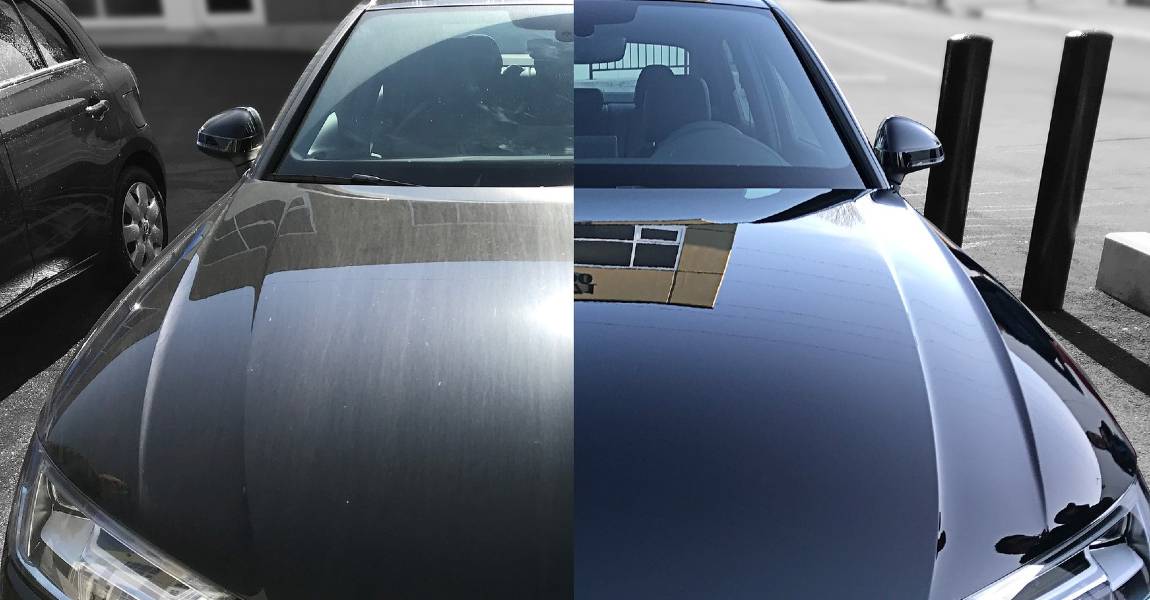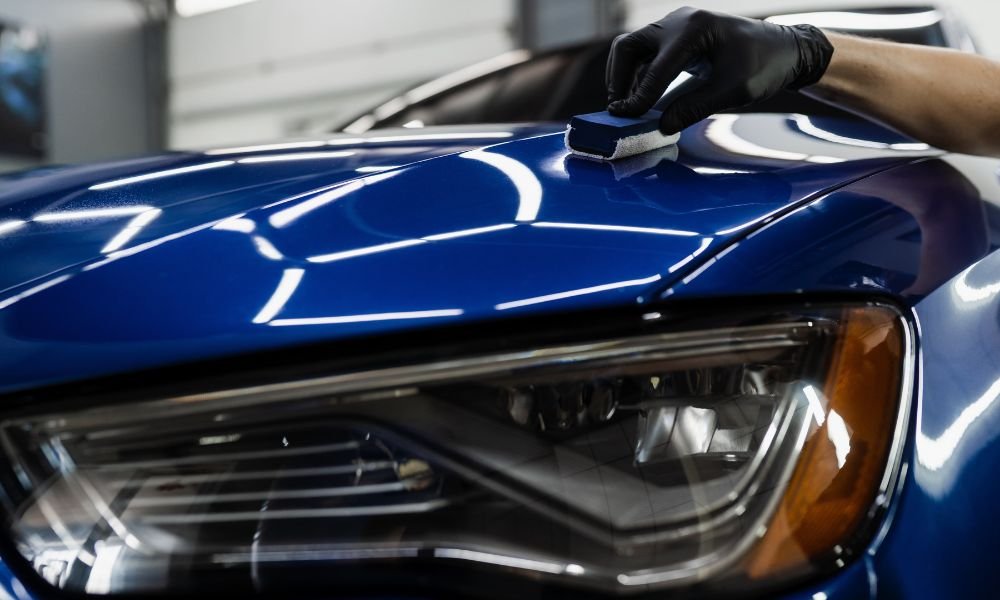Ceramic Coating vs. Sealants: Comprehending the Distinctions for Your Auto
Ceramic Coating vs. Sealants: Comprehending the Distinctions for Your Auto
Blog Article
The Value of Ceramic Coating: Shielding Your Vehicle's Exterior With Precision
In an age where maintaining the visual and practical integrity of your automobile is extremely important, ceramic covering emerges as an essential solution. With its unique bonding homes, ceramic finishing offers a degree of defense that far exceeds typical waxing techniques.
Benefits of Ceramic Coating
When it comes to maintaining an auto's visual allure, ceramic finish offers significant benefits. By forming a semi-permanent bond with the car's paint, ceramic layers effectively avoid oxidation and fading, ensuring that the car maintains a glossy, showroom-like surface for an extended period.
In addition to its protective top qualities, ceramic finish offers remarkable hydrophobic buildings, creating water and other fluids to bead off easily. This feature streamlines the cleansing process, as dirt and particles are less most likely to abide by the surface area, lowering the regularity and effort required for maintenance. In addition, the finishing's resistance to chemical discolorations from acidic contaminants like bird droppings and tree sap is an additional notable advantage, minimizing possible paint damages.
Ceramic finishings also boost scratch resistance, offering a layer that can take in minor abrasions and swirl marks. This feature is especially valuable in keeping an immaculate surface, decreasing the chance of noticeable flaws and protecting the integrity of the car's paintwork in time.

Exactly How Ceramic Coating Works
Comprehending the technicians behind ceramic covering exposes its efficiency as a protective solution for lorries. Ceramic finishes are essentially fluid polymer applications that chemically bond with an auto's factory paint, producing a protective layer.
Application of ceramic layer includes a precise procedure. The car's surface need to be extensively cleaned and decontaminated to guarantee optimum bond. When applied, the liquid polymer develops a semi-permanent bond with the paint, setting right into a clear, resilient shield. This shield boosts the automobile's gloss and hydrophobic residential or commercial properties, assisting in simpler cleansing by causing water and contaminants to bead and slide off effortlessly.
Moreover, the finishing's molecular framework gives resistance to minor scratches and chemical discolorations. Unlike waxes or sealants that sit on top of the paint, ceramic coatings incorporate with the surface area, using lasting defense. This combination is basic to its performance, ensuring the automobile's surface continues to be beautiful for several years.
Contrasting Ceramic Coating to Alternatives
In the world of automotive defense, ceramic finishing stands as a formidable alternative when contrasted to standard options such as waxes and sealers. While waxes use a temporary lustrous surface, typically lasting just a few weeks to months, ceramic layers give a longer-lasting service, typically withstanding for years. This longevity is credited to the chemical bonding that happens when ceramic finishings are used, forming a solid layer that is resistant to ecological dangers.
Contrastingly, sealants, although more resilient than waxes, still disappoint the robust defense used by ceramic layers. Sealers can usually last for as much as a year, supplying an artificial shield versus particular aspects. They lack the remarkable hydrophobic residential properties and UV defense that ceramic finishings deliver.
Additionally, ceramic coatings provide boosted scrape resistance, which neither waxes nor sealers can successfully match. In summary, while conventional waxes and sealers offer fundamental security, ceramic layers offer a comprehensive, long-lasting solution that dramatically pop over to this web-site improves and protects the lorry's exterior surface.
Application Process Described
Using ceramic coating to a vehicle calls for a careful procedure to make certain optimal results and resilience. The first step entails completely cleansing the auto's surface area to remove dust, grease, and previous waxes. This is vital for making certain the coating adheres effectively. A pH-neutral hair shampoo and a clay bar therapy are commonly utilized to attain a beautiful surface. When cleaned, the car is dried and brightened to eliminate any flaws, as any type of existing scratches or swirls can end up being a lot more noticable after the finish is used.
Adhering to surface prep work, the application of the ceramic finish begins. Using an applicator pad, the ceramic finishing is applied in tiny areas to make sure even coverage.
After application, the covering calls for a specific healing period, throughout which the vehicle ought to be safeguarded from water and pollutants. This curing click to find out more process can differ depending upon the item however usually ranges from 24 to two days. Ultimately, this comprehensive process is essential in attaining a resilient and glossy coating.
Upkeep Tips for Longevity
To preserve the durability of a ceramic finish, adherence to a regimented upkeep regimen is necessary. Prevent automated car washes, as their severe brushes can endanger the finish's integrity.
Post-wash, drying the lorry with a clean microfiber towel protects against water spots that may deteriorate the finish with time. In addition, use a ceramic finish booster every few months. These boosters enhance the hydrophobic residential or commercial properties and improve the finish's protective capabilities, ensuring it remains effective versus pollutants.
Bear in mind that vehicle parking places play a vital function in upkeep. ceramic coating. Whenever possible, park in shaded locations to reduce UV exposure, which can i was reading this gradually deteriorate the layer. For lasting storage space, take into consideration using an automobile cover for included defense versus environmental components
Conclusion
To conclude, ceramic finishing functions as an essential protective layer for vehicle exteriors, using long-lasting defense versus environmental factors such as uv, dirt, and gunk rays. By creating a semi-permanent bond with the paint, it improves aesthetic allure while maintaining the auto's value. Its hydrophobic buildings facilitate easier upkeep, distinguishing it from alternative protective approaches. Comprehending the application process and adhering to maintenance referrals are important for optimizing the durability and efficiency of ceramic coating.
When it comes to preserving a vehicle's aesthetic appeal, ceramic finish provides substantial benefits. By creating a semi-permanent bond with the vehicle's paint, ceramic layers successfully stop oxidation and fading, making certain that the cars and truck maintains a glossy, showroom-like surface for an extensive duration. Ceramic layers are essentially fluid polymer applications that chemically bond with a car's manufacturing facility paint, producing a protective layer. In recap, while conventional waxes and sealers supply basic protection, ceramic layers offer an extensive, long-lasting remedy that dramatically boosts and preserves the lorry's exterior surface.

Report this page